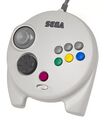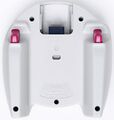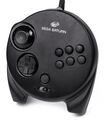Difference between revisions of "3D Control Pad"
From Sega Retro
m (Text replace - "[[Microsoft Xbox" to "[[Xbox") |
|||
| Line 23: | Line 23: | ||
The 3D Control Pad did not see widespread adoption for the same reason the Sega Saturn failed to capture a large share of the market in the west. The Saturn's 3D output was low, and as the controllers were never bundled with the console, consumers were more familiar with the standard Saturn control pads. It also has some design issues, namely the fact it is quite a lot bigger than most other controllers and arguably less comfortable than the standard pads for certain genres. Even in Japan, where the Saturn was successful, the controller was not used by many games (only 49, with 23 of them coming from Sega, though some developers, such as [[KID]], supported it quite a bit (in their case, [[Kiss Yori...|even after Sega introduced the Dreamcast]])). | The 3D Control Pad did not see widespread adoption for the same reason the Sega Saturn failed to capture a large share of the market in the west. The Saturn's 3D output was low, and as the controllers were never bundled with the console, consumers were more familiar with the standard Saturn control pads. It also has some design issues, namely the fact it is quite a lot bigger than most other controllers and arguably less comfortable than the standard pads for certain genres. Even in Japan, where the Saturn was successful, the controller was not used by many games (only 49, with 23 of them coming from Sega, though some developers, such as [[KID]], supported it quite a bit (in their case, [[Kiss Yori...|even after Sega introduced the Dreamcast]])). | ||
| − | However, the 3D Control Pad can be credited for many common features seen in controllers today. Its design greatly influenced that of the [[Controller (Dreamcast)|Sega Dreamcast Controller]]. Analogue shoulder buttons have since been adopted by both [[Nintendo]] and [[Microsoft]] in the [[Nintendo GameCube]], [[ | + | However, the 3D Control Pad can be credited for many common features seen in controllers today. Its design greatly influenced that of the [[Controller (Dreamcast)|Sega Dreamcast Controller]]. Analogue shoulder buttons have since been adopted by both [[Nintendo]] and [[Microsoft]] in the [[Nintendo GameCube]], [[Xbox]] and [[Xbox 360]]. Likewise, the idea of having the analogue stick positioned on the left hand side above the D-Pad has been adopted by both companies. |
==List of Supported Games== | ==List of Supported Games== | ||
Revision as of 12:07, 27 December 2012
This short article is in need of work. You can help Sega Retro by adding to it.
| 320x240px | |||||
| 3D Control Pad | |||||
|---|---|---|---|---|---|
| Made for: Sega Saturn | |||||
| Manufacturer: Sega | |||||
|
The 3D Control Pad, called the Sega Multi Controller (セガマルチコントローラー) in Japan, is a control pad developed for use with the Sega Saturn. Debuting with NiGHTS into Dreams, it was Sega's answer to the then revolutionary Nintendo 64 controller, which featured an analogue stick as opposed to relying solely on D-Pads. Analogue sticks generally allow for greater precision in a 3D environment, and unlike previous generations, by the time this controller debuted in 1996 3D was seen as the way forward for large parts of the gaming industry.
The 3D Control Pad builds on the features already seen in the standard Saturn Control Pad, containing an eight-direcional D-Pad and ![]() ,
, ![]() ,
, ![]() ,
, ![]() ,
, ![]() ,
, ![]() and START buttons. New to the controller was an analogue thumbstick (or "3D Directional Pad" as Sega called it), positioned on the left hand side of the controller above the D-Pad.
and START buttons. New to the controller was an analogue thumbstick (or "3D Directional Pad" as Sega called it), positioned on the left hand side of the controller above the D-Pad.
To avoid compatibility issues, the analog controller has a switch under the start button to swap between "Digital" and "Analogue" modes. Switching to "Digital" mode disables all analogue settings, essentially turning the controller back into a standard control pad. This switch was vital, because earlier games were not built to understand the analogue technology and will not function correctly if the wrong mode is chosen. The original PlayStation and its latter dual-analogue controllers also required this feature.
The 3D Control Pad is not just notable for its analogue stick. Also inlcuded are analogue ![]() and
and ![]() shoulder triggers, the first system to contain these. The controller lead can also be removed from the controller for storage purposes.
shoulder triggers, the first system to contain these. The controller lead can also be removed from the controller for storage purposes.
The 3D Control Pad did not see widespread adoption for the same reason the Sega Saturn failed to capture a large share of the market in the west. The Saturn's 3D output was low, and as the controllers were never bundled with the console, consumers were more familiar with the standard Saturn control pads. It also has some design issues, namely the fact it is quite a lot bigger than most other controllers and arguably less comfortable than the standard pads for certain genres. Even in Japan, where the Saturn was successful, the controller was not used by many games (only 49, with 23 of them coming from Sega, though some developers, such as KID, supported it quite a bit (in their case, even after Sega introduced the Dreamcast)).
However, the 3D Control Pad can be credited for many common features seen in controllers today. Its design greatly influenced that of the Sega Dreamcast Controller. Analogue shoulder buttons have since been adopted by both Nintendo and Microsoft in the Nintendo GameCube, Xbox and Xbox 360. Likewise, the idea of having the analogue stick positioned on the left hand side above the D-Pad has been adopted by both companies.
List of Supported Games
- note: this list is missing games not released in Japan and may use Japanese names for games released in the west as well
- Azel: Panzer Dragoon RPG
- Baroque
- Burning Rangers
- Can Can Bunny Extra
- Can Can Bunny Premiere 2
- Choro Q Park
- Code R
- Christmas NiGHTS
- Croc: Legend of the Gobbos
- Daisuki
- Dark Savior
- Daytona USA: Championship Circuit Edition
- Daytona USA CCE Netlink Edition
- Daytona USA Circuit Edition
- Deep Fear
- Die Hard Trilogy
- Digital Pinball: Necronomicon
- Dungeon Master Nexus
- Duke Nukem 3D
- Enemy Zero
- Fighters Megamix
- Fuusui Sensei
- G Vector
- J. League Go Go Goal!
- Kiss Yori...
- Magic Carpet
- Manx TT Superbike
- MechWarrior 2: 31st Century Combat
- NiGHTS into Dreams
- Over Drivin' GT-R
- Pia Carrot e Youkoso!!
- Planet Joker
- Ryuuteki Go Sennen
- Sega Ages
- Sega Ages After Burner II
- Sega Ages Galaxy Force II
- Sega Ages Memorial Selection VOL.2
- Sega Ages OutRun
- Sega Ages Power Drift
- Sega Ages VOL.2: Space Harrier
- Sega Rally Championship Plus
- Sega Touring Car Championship
- Sega Worldwide Soccer '98
- Sky Target
- Sonic 3D: Flickies' Island
- Sonic Jam
- Sonic R
- Soukyugurentai
- Soviet Strike
- StarFighter 3000
- Touge King the Spirits 2
- Virtuacall S
- Virtua Cop 2
- Virtual Kyoutei
- Virtual Kyoutei 2
- Wipeout XL
- World Cup '98 France: Road to Win
Gallery
Physical Scans
| Saturn, US (NiGHTS into Dreams) |
|---|
| Saturn, EU (NiGHTS into Dreams) |
|---|
| Saturn, JP (NiGHTS into Dreams) |
|---|
| Saturn, JP (Magic Carpet) |
|---|
US Manual
- 3dpad-1.jpg
Front Side
- 3dpad-2.jpg
Back Side

















